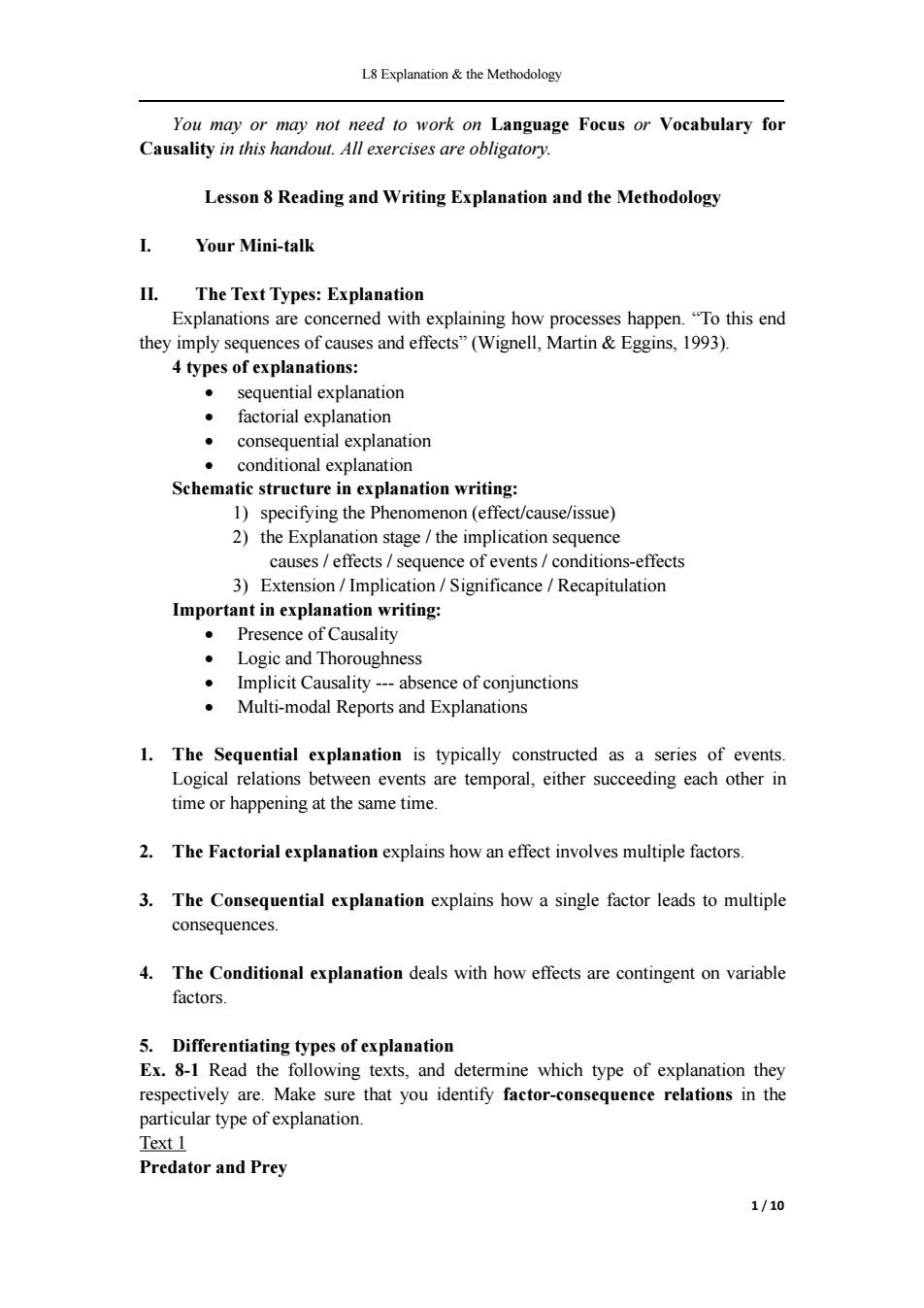
L8 Explanation&the Methodology You may or may not need to work on Language Focus or Vocabulary for Causality in this handout.All exercises are obligatory. Lesson 8 Reading and Writing Explanation and the Methodology 1. Your Mini-talk II.The Text Types:Explanation Explanations are concerned with explaining how processes happen."To this end they imply sequences of causes and effects"(Wignell,Martin Eggins,1993). 4 types of explanations: sequential explanation factorial explanation consequential explanation conditional explanation Schematic structure in explanation writing: 1)specifying the Phenomenon (effect/cause/issue) 2)the Explanation stage the implication sequence causes/effects/sequence of events conditions-effects 3)Extension/Implication/Significance/Recapitulation Important in explanation writing: Presence of Causality Logic and Thoroughness Implicit Causality---absence of conjunctions Multi-modal Reports and Explanations 1.The Sequential explanation is typically constructed as a series of events. Logical relations between events are temporal,either succeeding each other in time or happening at the same time. 2.The Factorial explanation explains how an effect involves multiple factors 3.The Consequential explanation explains how a single factor leads to multiple consequences. 4.The Conditional explanation deals with how effects are contingent on variable factors. 5.Differentiating types of explanation Ex.8-1 Read the following texts,and determine which type of explanation they respectively are.Make sure that you identify factor-consequence relations in the particular type of explanation. Text 1 Predator and Prey 1/10
L8 Explanation & the Methodology 1 / 10 You may or may not need to work on Language Focus or Vocabulary for Causality in this handout. All exercises are obligatory. Lesson 8 Reading and Writing Explanation and the Methodology I. Your Mini-talk II. The Text Types: Explanation Explanations are concerned with explaining how processes happen. “To this end they imply sequences of causes and effects” (Wignell, Martin & Eggins, 1993). 4 types of explanations: sequential explanation factorial explanation consequential explanation conditional explanation Schematic structure in explanation writing: 1) specifying the Phenomenon (effect/cause/issue) 2) the Explanation stage / the implication sequence causes / effects / sequence of events / conditions-effects 3) Extension / Implication / Significance / Recapitulation Important in explanation writing: Presence of Causality Logic and Thoroughness Implicit Causality --- absence of conjunctions Multi-modal Reports and Explanations 1. The Sequential explanation is typically constructed as a series of events. Logical relations between events are temporal, either succeeding each other in time or happening at the same time. 2. The Factorial explanation explains how an effect involves multiple factors. 3. The Consequential explanation explains how a single factor leads to multiple consequences. 4. The Conditional explanation deals with how effects are contingent on variable factors. 5. Differentiating types of explanation Ex. 8-1 Read the following texts, and determine which type of explanation they respectively are. Make sure that you identify factor-consequence relations in the particular type of explanation. Text 1 Predator and Prey
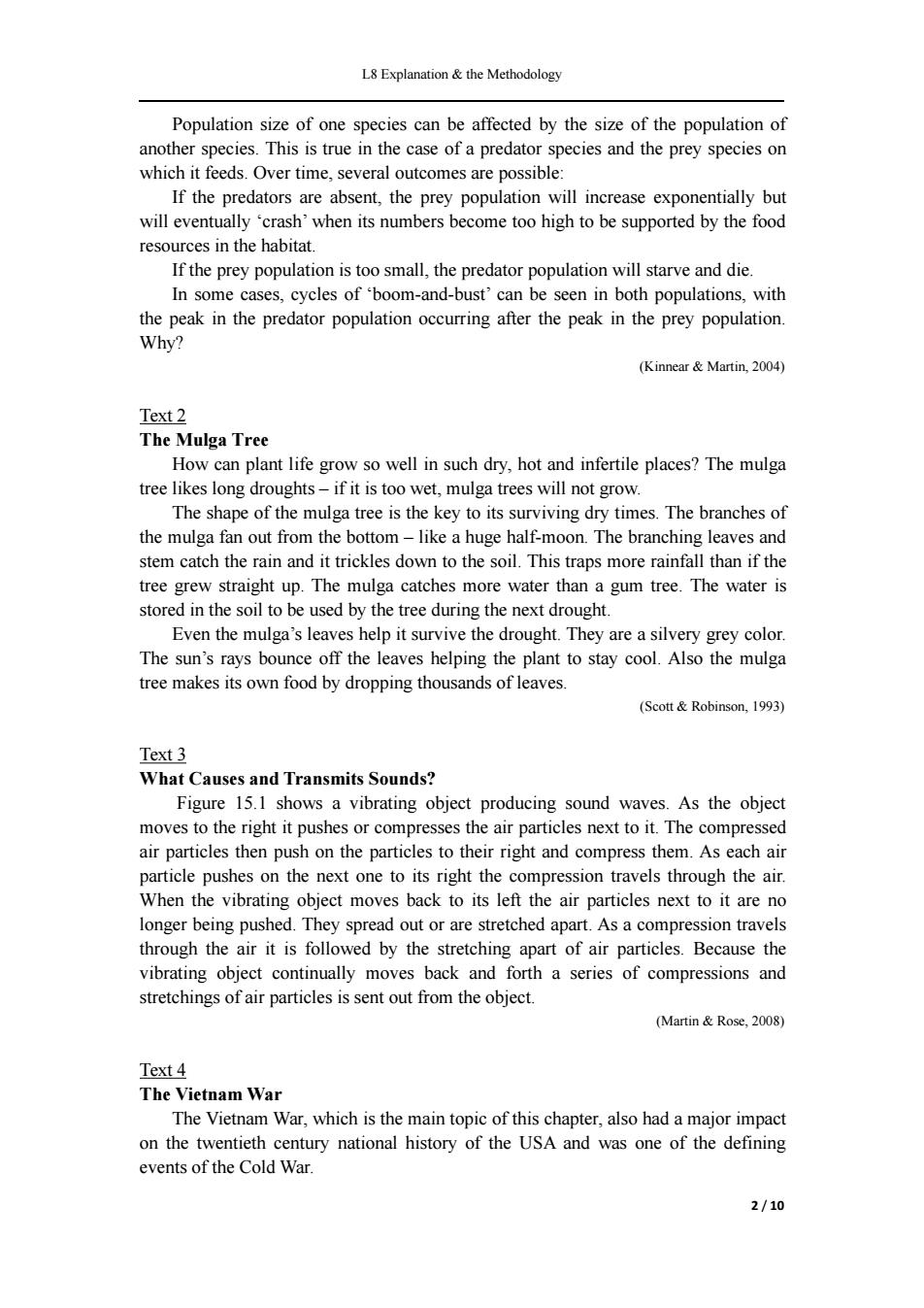
L8 Explanation&the Methodology Population size of one species can be affected by the size of the population of another species.This is true in the case of a predator species and the prey species on which it feeds.Over time,several outcomes are possible: If the predators are absent,the prey population will increase exponentially but will eventually crash'when its numbers become too high to be supported by the food resources in the habitat. If the prey population is too small,the predator population will starve and die. In some cases,cycles of boom-and-bust'can be seen in both populations,with the peak in the predator population occurring after the peak in the prey population. Why? (Kinnear Martin,2004) Text 2 The Mulga Tree How can plant life grow so well in such dry,hot and infertile places?The mulga tree likes long droughts-if it is too wet,mulga trees will not grow. The shape of the mulga tree is the key to its surviving dry times.The branches of the mulga fan out from the bottom-like a huge half-moon.The branching leaves and stem catch the rain and it trickles down to the soil.This traps more rainfall than if the tree grew straight up.The mulga catches more water than a gum tree.The water is stored in the soil to be used by the tree during the next drought. Even the mulga's leaves help it survive the drought.They are a silvery grey color. The sun's rays bounce off the leaves helping the plant to stay cool.Also the mulga tree makes its own food by dropping thousands of leaves. (Scott Robinson,1993) Text 3 What Causes and Transmits Sounds? Figure 15.1 shows a vibrating object producing sound waves.As the object moves to the right it pushes or compresses the air particles next to it.The compressed air particles then push on the particles to their right and compress them.As each air particle pushes on the next one to its right the compression travels through the air. When the vibrating object moves back to its left the air particles next to it are no longer being pushed.They spread out or are stretched apart.As a compression travels through the air it is followed by the stretching apart of air particles.Because the vibrating object continually moves back and forth a series of compressions and stretchings of air particles is sent out from the object. (Martin Rose,2008) Text 4 The Vietnam War The Vietnam War,which is the main topic of this chapter,also had a major impact on the twentieth century national history of the USA and was one of the defining events of the Cold War. 2/10
L8 Explanation & the Methodology 2 / 10 Population size of one species can be affected by the size of the population of another species. This is true in the case of a predator species and the prey species on which it feeds. Over time, several outcomes are possible: If the predators are absent, the prey population will increase exponentially but will eventually ‘crash’ when its numbers become too high to be supported by the food resources in the habitat. If the prey population is too small, the predator population will starve and die. In some cases, cycles of ‘boom-and-bust’ can be seen in both populations, with the peak in the predator population occurring after the peak in the prey population. Why? (Kinnear & Martin, 2004) Text 2 The Mulga Tree How can plant life grow so well in such dry, hot and infertile places? The mulga tree likes long droughts – if it is too wet, mulga trees will not grow. The shape of the mulga tree is the key to its surviving dry times. The branches of the mulga fan out from the bottom – like a huge half-moon. The branching leaves and stem catch the rain and it trickles down to the soil. This traps more rainfall than if the tree grew straight up. The mulga catches more water than a gum tree. The water is stored in the soil to be used by the tree during the next drought. Even the mulga’s leaves help it survive the drought. They are a silvery grey color. The sun’s rays bounce off the leaves helping the plant to stay cool. Also the mulga tree makes its own food by dropping thousands of leaves. (Scott & Robinson, 1993) Text 3 What Causes and Transmits Sounds? Figure 15.1 shows a vibrating object producing sound waves. As the object moves to the right it pushes or compresses the air particles next to it. The compressed air particles then push on the particles to their right and compress them. As each air particle pushes on the next one to its right the compression travels through the air. When the vibrating object moves back to its left the air particles next to it are no longer being pushed. They spread out or are stretched apart. As a compression travels through the air it is followed by the stretching apart of air particles. Because the vibrating object continually moves back and forth a series of compressions and stretchings of air particles is sent out from the object. (Martin & Rose, 2008) Text 4 The Vietnam War The Vietnam War, which is the main topic of this chapter, also had a major impact on the twentieth century national history of the USA and was one of the defining events of the Cold War
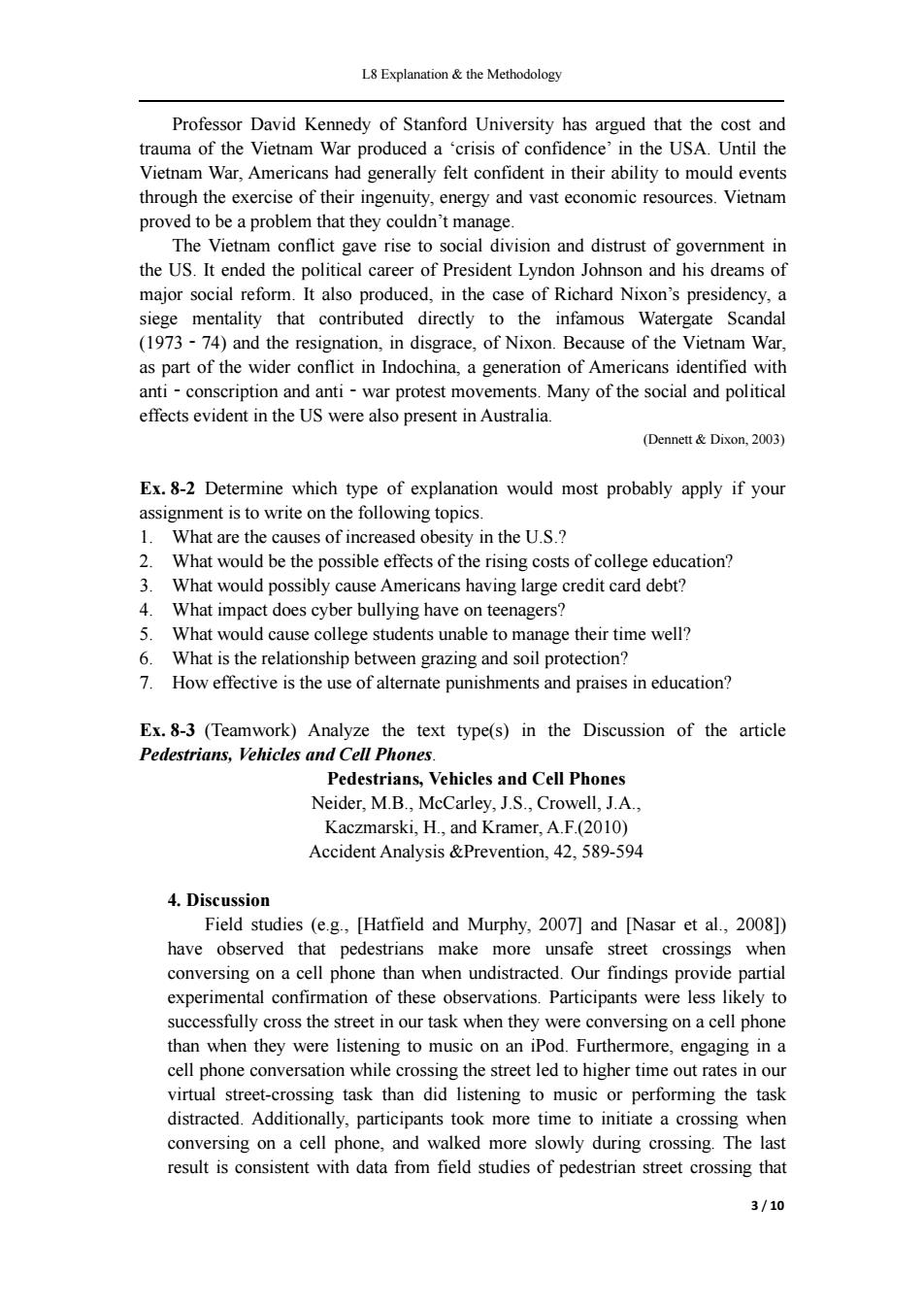
L8 Explanation&the Methodology Professor David Kennedy of Stanford University has argued that the cost and trauma of the Vietnam War produced a 'crisis of confidence'in the USA.Until the Vietnam War,Americans had generally felt confident in their ability to mould events through the exercise of their ingenuity,energy and vast economic resources.Vietnam proved to be a problem that they couldn't manage. The Vietnam conflict gave rise to social division and distrust of government in the US.It ended the political career of President Lyndon Johnson and his dreams of major social reform.It also produced,in the case of Richard Nixon's presidency,a siege mentality that contributed directly to the infamous Watergate Scandal (1973-74)and the resignation,in disgrace,of Nixon.Because of the Vietnam War, as part of the wider conflict in Indochina,a generation of Americans identified with anti -conscription and anti-war protest movements.Many of the social and political effects evident in the US were also present in Australia (Dennett Dixon,2003) Ex.8-2 Determine which type of explanation would most probably apply if your assignment is to write on the following topics. 1.What are the causes of increased obesity in the U.S.? 2.What would be the possible effects of the rising costs of college education? 3.What would possibly cause Americans having large credit card debt? 4.What impact does cyber bullying have on teenagers? 5.What would cause college students unable to manage their time well? 6. What is the relationship between grazing and soil protection? 7.How effective is the use of alternate punishments and praises in education? Ex.8-3 (Teamwork)Analyze the text type(s)in the Discussion of the article Pedestrians,Vehicles and Cell Phones. Pedestrians,Vehicles and Cell Phones Neider,M.B.,McCarley,J.S.,Crowell,J.A., Kaczmarski,H.,and Kramer,A.F.(2010) Accident Analysis &Prevention,42,589-594 4.Discussion Field studies (e.g,[Hatfield and Murphy,2007]and [Nasar et al.,2008]) have observed that pedestrians make more unsafe street crossings when conversing on a cell phone than when undistracted.Our findings provide partial experimental confirmation of these observations.Participants were less likely to successfully cross the street in our task when they were conversing on a cell phone than when they were listening to music on an iPod.Furthermore,engaging in a cell phone conversation while crossing the street led to higher time out rates in our virtual street-crossing task than did listening to music or performing the task distracted.Additionally,participants took more time to initiate a crossing when conversing on a cell phone,and walked more slowly during crossing.The last result is consistent with data from field studies of pedestrian street crossing that 3/10
L8 Explanation & the Methodology 3 / 10 Professor David Kennedy of Stanford University has argued that the cost and trauma of the Vietnam War produced a ‘crisis of confidence’ in the USA. Until the Vietnam War, Americans had generally felt confident in their ability to mould events through the exercise of their ingenuity, energy and vast economic resources. Vietnam proved to be a problem that they couldn’t manage. The Vietnam conflict gave rise to social division and distrust of government in the US. It ended the political career of President Lyndon Johnson and his dreams of major social reform. It also produced, in the case of Richard Nixon’s presidency, a siege mentality that contributed directly to the infamous Watergate Scandal (1973‐74) and the resignation, in disgrace, of Nixon. Because of the Vietnam War, as part of the wider conflict in Indochina, a generation of Americans identified with anti‐conscription and anti‐war protest movements. Many of the social and political effects evident in the US were also present in Australia. (Dennett & Dixon, 2003) Ex. 8-2 Determine which type of explanation would most probably apply if your assignment is to write on the following topics. 1. What are the causes of increased obesity in the U.S.? 2. What would be the possible effects of the rising costs of college education? 3. What would possibly cause Americans having large credit card debt? 4. What impact does cyber bullying have on teenagers? 5. What would cause college students unable to manage their time well? 6. What is the relationship between grazing and soil protection? 7. How effective is the use of alternate punishments and praises in education? Ex. 8-3 (Teamwork) Analyze the text type(s) in the Discussion of the article Pedestrians, Vehicles and Cell Phones. Pedestrians, Vehicles and Cell Phones Neider, M.B., McCarley, J.S., Crowell, J.A., Kaczmarski, H., and Kramer, A.F.(2010) Accident Analysis &Prevention, 42, 589-594 4. Discussion Field studies (e.g., [Hatfield and Murphy, 2007] and [Nasar et al., 2008]) have observed that pedestrians make more unsafe street crossings when conversing on a cell phone than when undistracted. Our findings provide partial experimental confirmation of these observations. Participants were less likely to successfully cross the street in our task when they were conversing on a cell phone than when they were listening to music on an iPod. Furthermore, engaging in a cell phone conversation while crossing the street led to higher time out rates in our virtual street-crossing task than did listening to music or performing the task distracted. Additionally, participants took more time to initiate a crossing when conversing on a cell phone, and walked more slowly during crossing. The last result is consistent with data from field studies of pedestrian street crossing that
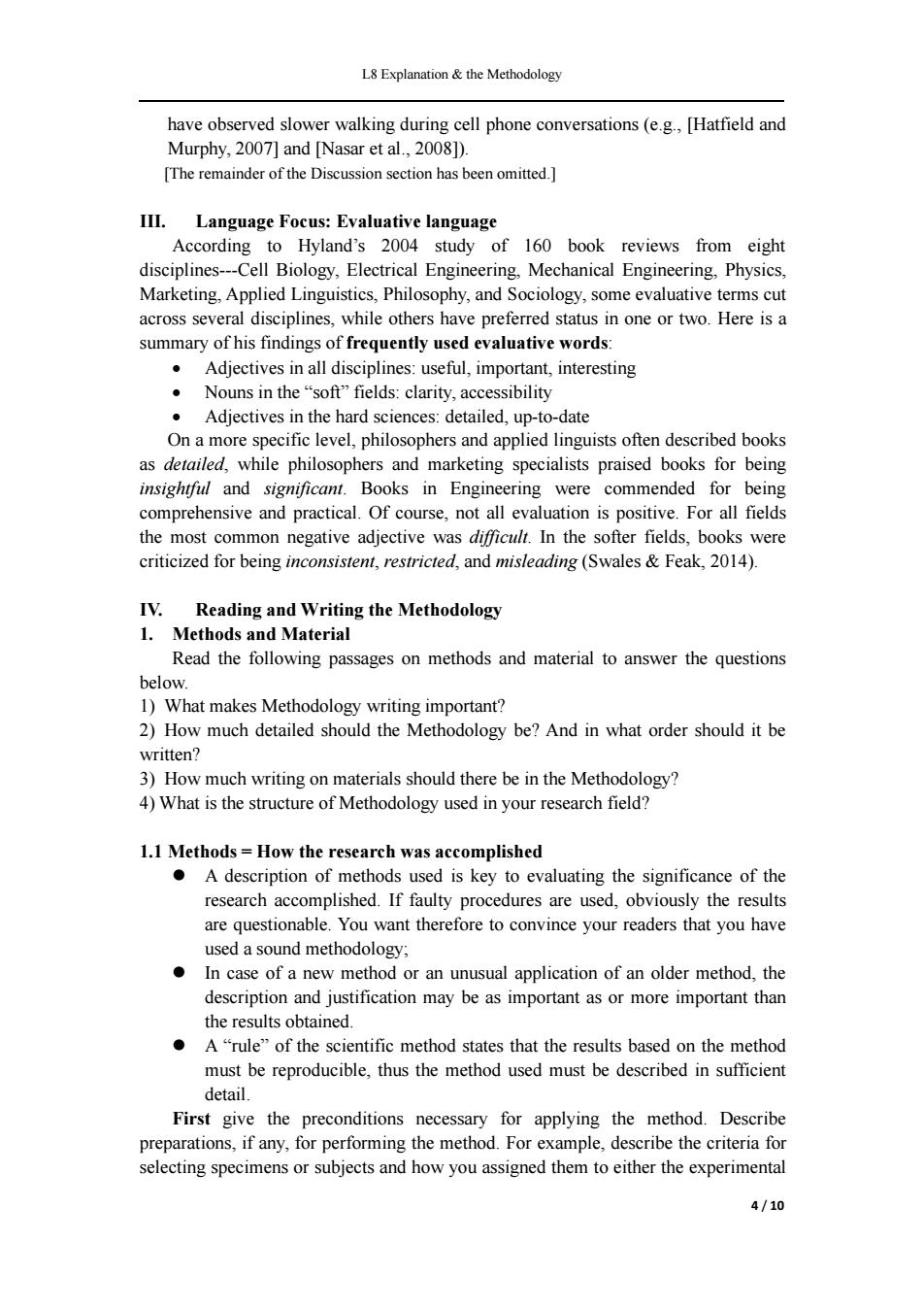
L8 Explanation the Methodology have observed slower walking during cell phone conversations(e.g.,[Hatfield and Murphy,2007]and [Nasar et al.,2008]). [The remainder of the Discussion section has been omitted.] III.Language Focus:Evaluative language According to Hyland's 2004 study of 160 book reviews from eight disciplines---Cell Biology,Electrical Engineering,Mechanical Engineering,Physics, Marketing,Applied Linguistics,Philosophy,and Sociology,some evaluative terms cut across several disciplines,while others have preferred status in one or two.Here is a summary of his findings of frequently used evaluative words: Adjectives in all disciplines:useful,important,interesting ·Nouns in the“soft”fields:clarity,accessibility Adjectives in the hard sciences:detailed,up-to-date On a more specific level,philosophers and applied linguists often described books as detailed,while philosophers and marketing specialists praised books for being insightful and significant.Books in Engineering were commended for being comprehensive and practical.Of course,not all evaluation is positive.For all fields the most common negative adjective was difficult.In the softer fields,books were criticized for being inconsistent,restricted,and misleading (Swales Feak,2014). IV.Reading and Writing the Methodology 1.Methods and Material Read the following passages on methods and material to answer the questions below. 1)What makes Methodology writing important? 2)How much detailed should the Methodology be?And in what order should it be written? 3)How much writing on materials should there be in the Methodology? 4)What is the structure of Methodology used in your research field? 1.1 Methods How the research was accomplished A description of methods used is key to evaluating the significance of the research accomplished.If faulty procedures are used,obviously the results are questionable.You want therefore to convince your readers that you have used a sound methodology; In case of a new method or an unusual application of an older method,the description and justification may be as important as or more important than the results obtained. A"rule"of the scientific method states that the results based on the method must be reproducible,thus the method used must be described in sufficient detail. First give the preconditions necessary for applying the method.Describe preparations,if any,for performing the method.For example,describe the criteria for selecting specimens or subjects and how you assigned them to either the experimental 4/10
L8 Explanation & the Methodology 4 / 10 have observed slower walking during cell phone conversations (e.g., [Hatfield and Murphy, 2007] and [Nasar et al., 2008]). [The remainder of the Discussion section has been omitted.] III. Language Focus: Evaluative language According to Hyland’s 2004 study of 160 book reviews from eight disciplines---Cell Biology, Electrical Engineering, Mechanical Engineering, Physics, Marketing, Applied Linguistics, Philosophy, and Sociology, some evaluative terms cut across several disciplines, while others have preferred status in one or two. Here is a summary of his findings of frequently used evaluative words: Adjectives in all disciplines: useful, important, interesting Nouns in the “soft” fields: clarity, accessibility Adjectives in the hard sciences: detailed, up-to-date On a more specific level, philosophers and applied linguists often described books as detailed, while philosophers and marketing specialists praised books for being insightful and significant. Books in Engineering were commended for being comprehensive and practical. Of course, not all evaluation is positive. For all fields the most common negative adjective was dif icult. In the softer fields, books were criticized for being inconsistent, restricted, and misleading (Swales & Feak, 2014). IV. Reading and Writing the Methodology 1. Methods and Material Read the following passages on methods and material to answer the questions below. 1) What makes Methodology writing important? 2) How much detailed should the Methodology be? And in what order should it be written? 3) How much writing on materials should there be in the Methodology? 4) What is the structure of Methodology used in your research field? 1.1 Methods = How the research was accomplished A description of methods used is key to evaluating the significance of the research accomplished. If faulty procedures are used, obviously the results are questionable. You want therefore to convince your readers that you have used a sound methodology; In case of a new method or an unusual application of an older method, the description and justification may be as important as or more important than the results obtained. A “rule” of the scientific method states that the results based on the method must be reproducible, thus the method used must be described in sufficient detail. First give the preconditions necessary for applying the method. Describe preparations, if any, for performing the method. For example, describe the criteria for selecting specimens or subjects and how you assigned them to either the experimental
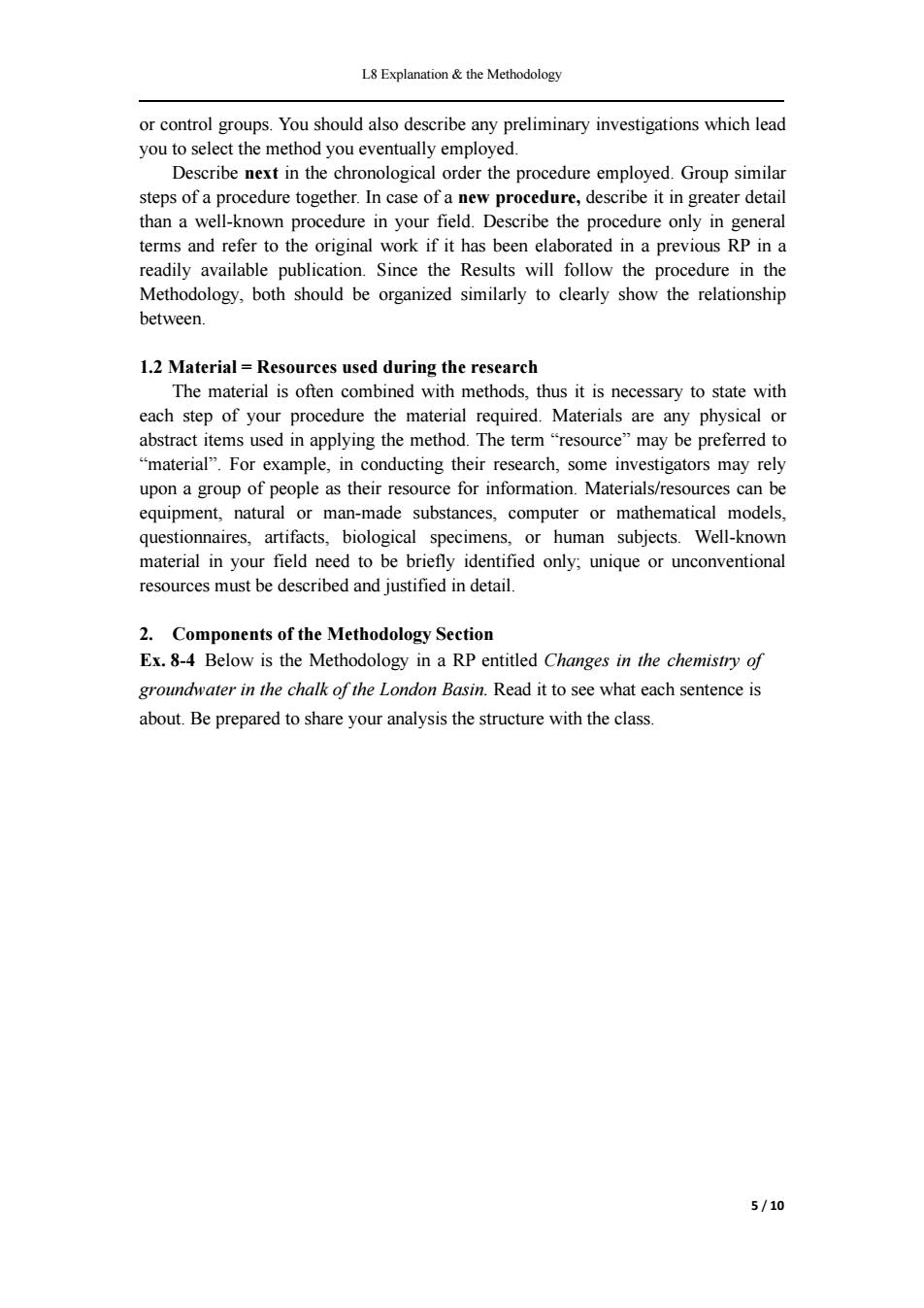
L8 Explanation&the Methodology or control groups.You should also describe any preliminary investigations which lead you to select the method you eventually employed. Describe next in the chronological order the procedure employed.Group similar steps of a procedure together.In case of a new procedure,describe it in greater detail than a well-known procedure in your field.Describe the procedure only in general terms and refer to the original work if it has been elaborated in a previous RP in a readily available publication.Since the Results will follow the procedure in the Methodology,both should be organized similarly to clearly show the relationship between. 1.2 Material Resources used during the research The material is often combined with methods,thus it is necessary to state with each step of your procedure the material required.Materials are any physical or abstract items used in applying the method.The term "resource"may be preferred to "material".For example,in conducting their research,some investigators may rely upon a group of people as their resource for information.Materials/resources can be equipment,natural or man-made substances,computer or mathematical models, questionnaires,artifacts,biological specimens,or human subjects.Well-known material in your field need to be briefly identified only;unique or unconventional resources must be described and justified in detail. 2.Components of the Methodology Section Ex.8-4 Below is the Methodology in a RP entitled Changes in the chemistry of groundwater in the chalk of the London Basin.Read it to see what each sentence is about.Be prepared to share your analysis the structure with the class. 5/10
L8 Explanation & the Methodology 5 / 10 or control groups. You should also describe any preliminary investigations which lead you to select the method you eventually employed. Describe next in the chronological order the procedure employed. Group similar steps of a procedure together. In case of a new procedure, describe it in greater detail than a well-known procedure in your field. Describe the procedure only in general terms and refer to the original work if it has been elaborated in a previous RP in a readily available publication. Since the Results will follow the procedure in the Methodology, both should be organized similarly to clearly show the relationship between. 1.2 Material = Resources used during the research The material is often combined with methods, thus it is necessary to state with each step of your procedure the material required. Materials are any physical or abstract items used in applying the method. The term “resource” may be preferred to “material”. For example, in conducting their research, some investigators may rely upon a group of people as their resource for information. Materials/resources can be equipment, natural or man-made substances, computer or mathematical models, questionnaires, artifacts, biological specimens, or human subjects. Well-known material in your field need to be briefly identified only; unique or unconventional resources must be described and justified in detail. 2. Components of the Methodology Section Ex. 8-4 Below is the Methodology in a RP entitled Changes in the chemistry of groundwater in the chalk of the London Basin. Read it to see what each sentence is about. Be prepared to share your analysis the structure with the class